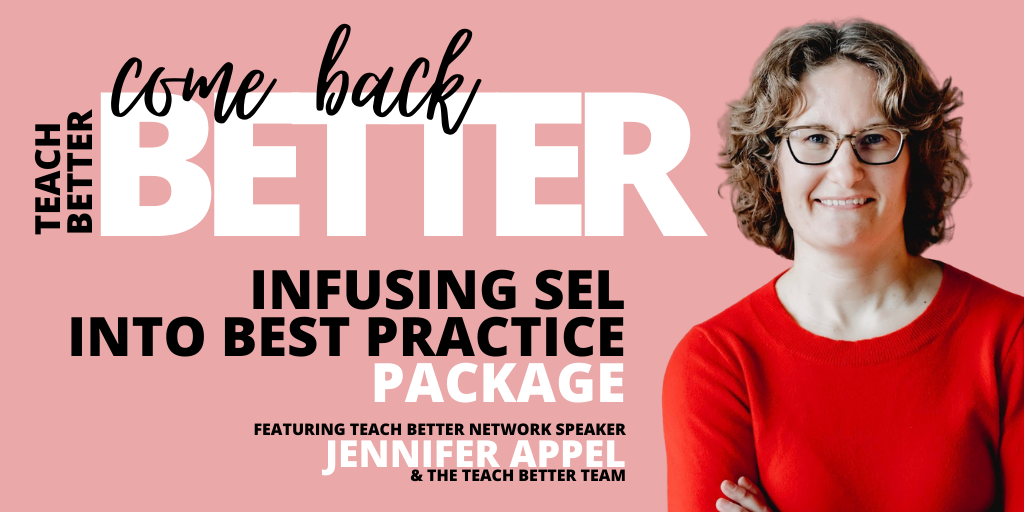TL;DR:
- Planning for social emotional learning in the new normal.
- Strategies to prioritize SEL and the whole child, including being flexible, focusing on social issues and changes, checking in with others and meeting them with empathy, and ensuring that we are taking time to understand where students are at in their learning.
“New beginnings are often disguised as painful endings” – Lao Tzu.
We have seen our world go through a global pandemic and face social injustice head-on within a few months. And to top it off we were ending a school year, and would go months without seeing our students. We need to make some changes NOW so that we are ready for our amazing students in the fall.
But what will the fall look like? Will we all be in class? Will we have to wear masks all day? Rotating schedules? Distance learning? Or maybe a hybrid combination of them all? We have to be prepared for anything!
SEL should be about intentionally teaching the whole child to give them a voice to help others and themselves. Share on XFlexibility
When I taught college courses, I always encouraged my students to be prepared with LOTS of flexibility. Teachers never know what each day might bring. Perhaps a fire alarm could go off in the middle of a lesson, or a snow storm would hit and you wouldn’t have school for a week, or maybe a student will instantly need your support—in a big way!
I was right about having flexibility for all of the little things, but who would’ve thought we’d need to be this flexible because of a global pandemic? It certainly wasn’t on my radar!
We are trying to navigate academic content and Social Emotional Learning while serving the whole child. My husband, Hans Appel, author of Award a Winning Culture, would remind me: “perhaps content is just a vehicle to teach what matters most: Character, Excellence, and Community.” But how are we actually planning for the unknown?
Let’s examine the 3 parts of Social Emotional Learning and break them down with how we can help our students be successful in this “NEW” normal.
Part 1: SOCIAL in the New Normal
When I think of SOCIAL in SEL, I think about social justice. George Floyd’s death has provided us an overdue opportunity to establish conversations for change. It’s time to push for anti-racism, as we model and teach social aspects through a BETTER lens for our students. We need to be intentional and proactive in this historic new normal. The time for passivity is over!
Reacting to an observable injustice is okay, but educators are capable of creating generational community change when actively instructing students about race, culture, religion, and sexual orientation within our curriculums. We can’t just have a lesson about race and then move on.
It’s important to think about how race, religion, and culture affect everything that we are teaching. And how biases exist in our culture without us even knowing about them. We need to bring this to the attention of our students so that they can be intentional and proactive in situations. After reading the article called, “When SEL is Used as Another Form of Policing” in Medium education, I realized that people are misinterpreting what SEL is.
SEL to Empower
SEL is not a fancy way of having RULES at your school. It’s not designed to oppress a marginalized group. It’s quite literally a system for empowering others to live their best lives, with the necessary soft skills and character development that ensures thriving in an ever-changing post-pandemic world.
SEL should be about intentionally teaching the whole child to give them a voice to help others and themselves. This is NOT intended to be another way to enforce general rules to all students, therefore failing to consider their cultural heritage and humanness.
When we go back in the fall, think about how you can incorporate social justice into the fabric of your curriculum, instruction, and classroom. At a distance or in-person, you can start taking a proactive approach to social justice by keeping it at the forefront of all decisions, actions, and thoughts.
Part 2: EMOTIONAL in the New Normal
Emotions are going to be different for everyone and in every direction. Educators may have some anxiety, either because districts choose not to return school, or are faced with a re-entry into unsafe school settings. There will be teachers and students that love working from home and are sad to be back at school.
Additionally, there will be parents that are thrilled to send their kids back to us, while others may refuse to subject their child to the COVID risky atmosphere of in-person learning at a physical school. Again, emotional flexibility will be crucial as we slowly navigate this newness.
The biggest strategy that we need to model for our students, parents, and colleagues is empathy. It’s okay, to not be okay. Giving ourselves and others grace to communicate our need to make sense of this rapidly changing school system provides the necessary space to begin to heal.
We are feeling this way because of an understandable reason, rather than defiance or opposition. We’re genuinely struggling because the whole world has been turned upside down and we’re all simply working to make sense of the new.
The Importance of Check-Ins
Frequent check-ins with students, parents, and peers will be essential. How are you feeling today? What can I do to help today? Do you need a little time to sit and relax before you start working? Does a parent need an email from me today to let them know their child is okay? Do I need to allow my students to use their cell phones during the day so that they can text a parent and let them know how they are feeling? If we are still working remotely, perhaps daily/weekly Zooms can support students and parents who need to personally connect. What do we need to do that is going to help our students?
Furthermore, education can be inherently isolating during normal conditions. When considering social distancing, we must continue to support our peers through virtual PLC’s, staff meetings, and collaboration.
The truth is, we are pioneers in this work. This hasn’t happened in 100 years. Demonstrating empathy and understanding toward your entire school community is a best practice to walk together on this new school path.
[scroll down to keep reading]Part 3: LEARNING in the New Normal
What is learning going to be like? We have no idea. Some students we will have had parents who made them read for an hour every single day, solve math problems with them for fun, watched documentaries about important events in history, and complete family trivia at the dinner table.
On the other hand, we’ll also have kids who played Fortnite for a solid 6 months and nothing else. There will be kids that were so worried about their next meal, that they were out doing odd jobs to make money for their family. And, everything in between…so now what?
We have to meet students where they are at. What do they need from us to help them to progress academically?
We need to ASK the STUDENTS. Giving students a voice in their learning keeps us grounded to student needs, not some arbitrarily determined catch-all standard. We need to find out from them: Where are you at? How do you feel about this content? And what do you need from me?
Give a list of the topics and items that you will be teaching this year and ask the students which they feel will be strengths for them and which they will need a little extra guidance on. Then meet with your students and have a frank discussion about their skills and what they worked on when they were doing forced remote learning. Coming up with an individual plan through a mastery learning framework seems instrumental to truly meet learners where they are at. Remember, none of this needs to be physically at school; you can do this virtually as well.
Award Winning Culture reaches the whole child by looking at SEL through the lens of individual people and customizing it for their needs.
About Jennifer Appel
Jennifer Appel is an educator, coach, speaker, and writer who wants to create an environment where all students are able to learn and become passionate about serving others. She is the author of, Award Winning Dog. Additionally, she’s the Chief Heart Officer for the Teach Better Team, co-host of the Award Winning Culture podcast, and the Co-Creator of Award Winning Culture.
Jennifer is also a member of the Teach Better Speakers Network.


